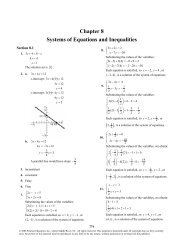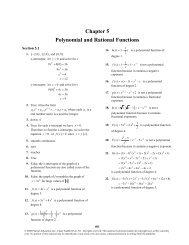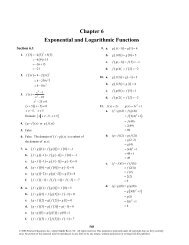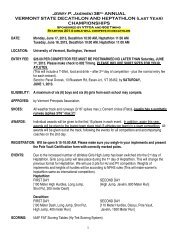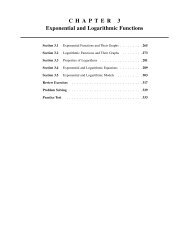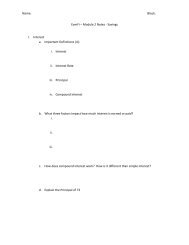C H A P T E R 2 Polynomial and Rational Functions
C H A P T E R 2 Polynomial and Rational Functions
C H A P T E R 2 Polynomial and Rational Functions
Create successful ePaper yourself
Turn your PDF publications into a flip-book with our unique Google optimized e-Paper software.
92. (a)<br />
93.<br />
(c)<br />
200<br />
7<br />
140<br />
V 4<br />
3r 3 r 2 4r (b)<br />
V 4<br />
3r 3 4r 3<br />
150<br />
0<br />
0<br />
16<br />
3 r 3<br />
The model is a good fit to the actual data.<br />
13<br />
2<br />
(d)<br />
r ≥ 0<br />
r 1.93 ft<br />
Section 2.2 <strong>Polynomial</strong> <strong>Functions</strong> of Higher Degree 165<br />
V 120 ft 3 16<br />
3 r 3<br />
length 4r 7.72 ft<br />
y 1 0.139t 3 4.42t 2 51.1t 39 94.<br />
95. Midwest:<br />
97.<br />
South:<br />
y 218 $223.472 thous<strong>and</strong> $223,472<br />
Since the models are both cubic functions with positive<br />
leading coefficients, both will increase without bound<br />
as t increases, thus should only be used for short term<br />
projections.<br />
(a)<br />
y 0.056t 3 1.73t 2 23.8t 29<br />
180<br />
7<br />
120<br />
13<br />
The data fit the model closely.<br />
y 118 $259.368 thous<strong>and</strong> $259,368 96. Answers will vary.<br />
G 0.003t 3 0.137t 2 0.458t 0.839,<br />
60<br />
−10 45<br />
−5<br />
(b) The tree is growing most rapidly at t 15.<br />
102. (a) Degree: 3<br />
Leading coefficient: Positive<br />
(b) Degree: 2<br />
Leading coefficient: Positive<br />
2 ≤ t ≤ 34<br />
(c)<br />
Example: The median price of homes in the South are<br />
all lower than those in the Midwest. The curves do<br />
not intersect.<br />
y 0.009t 2 0.274t 0.458<br />
b 0.274<br />
15.222<br />
2a 20.009<br />
y15.222 2.543<br />
Vertex 15.22, 2.54<br />
(d) The x-value of the vertex in part (c) is approximately<br />
equal to the value found in part (b).<br />
98. R <br />
The point of diminishing returns (where the graph<br />
changes from curving upward to curving downward)<br />
occurs when x 200. The point is 200, 160 which<br />
corresponds to spending $2,000,000 on advertising to<br />
obtain a revenue of $160 million.<br />
1<br />
100,000x 3 600x2 99. False. A fifth degree polynomial can have at most four<br />
turning points.<br />
100. True. f x x 1 has one repeated solution.<br />
6<br />
(c) Degree: 4<br />
Leading coefficient: Positive<br />
(d) Degree: 5<br />
Leading coefficient: Positive<br />
101. True. A polynomial of degree 7 with a negative leading<br />
coefficient rises to the left <strong>and</strong> falls to the right.





